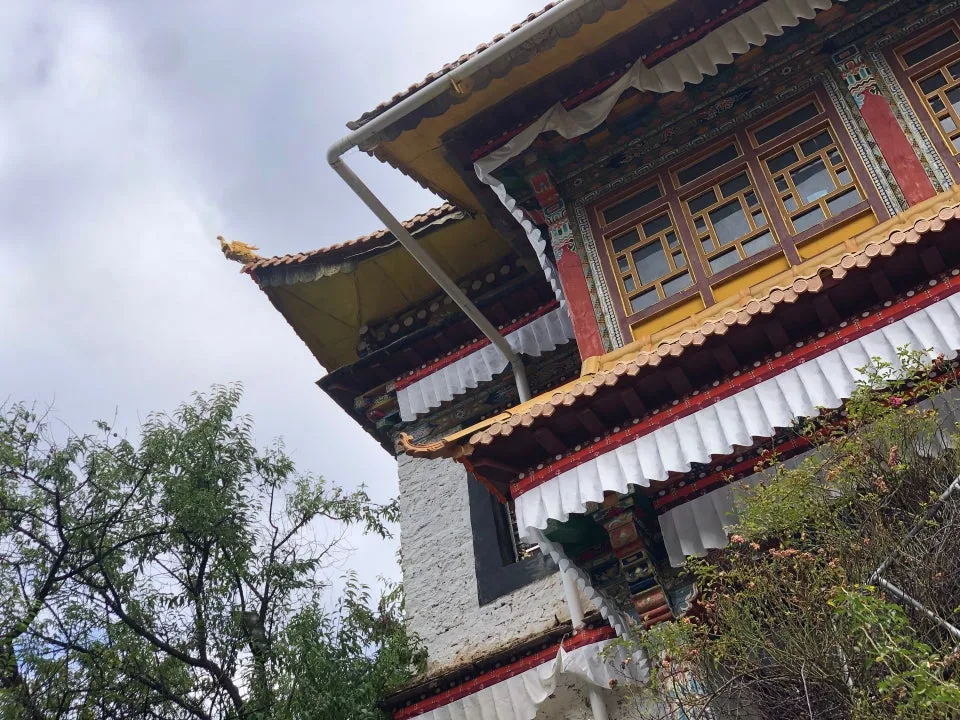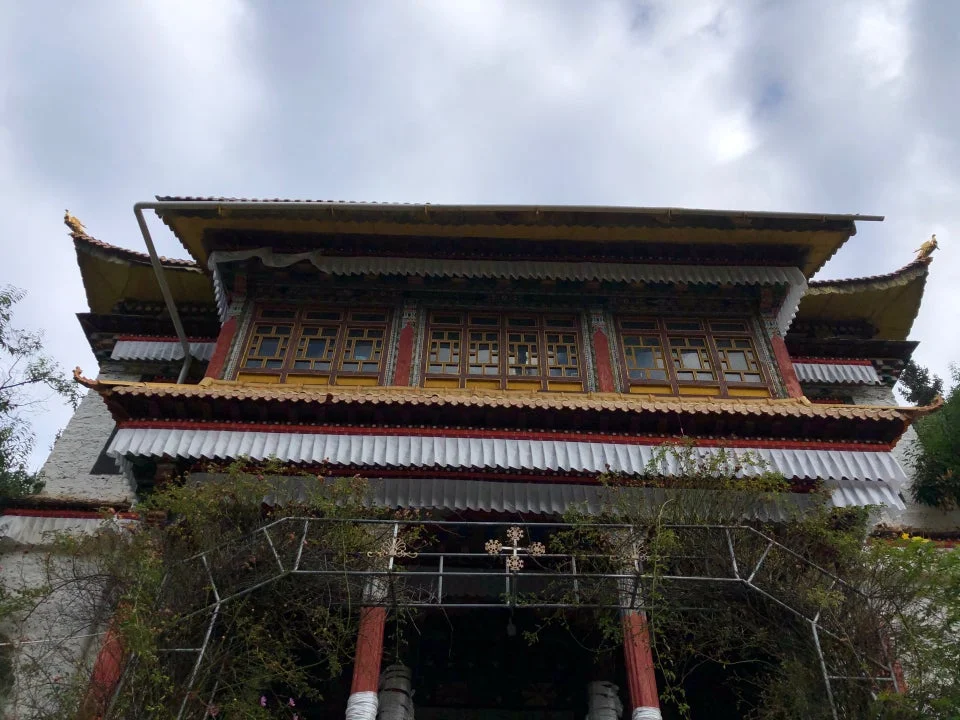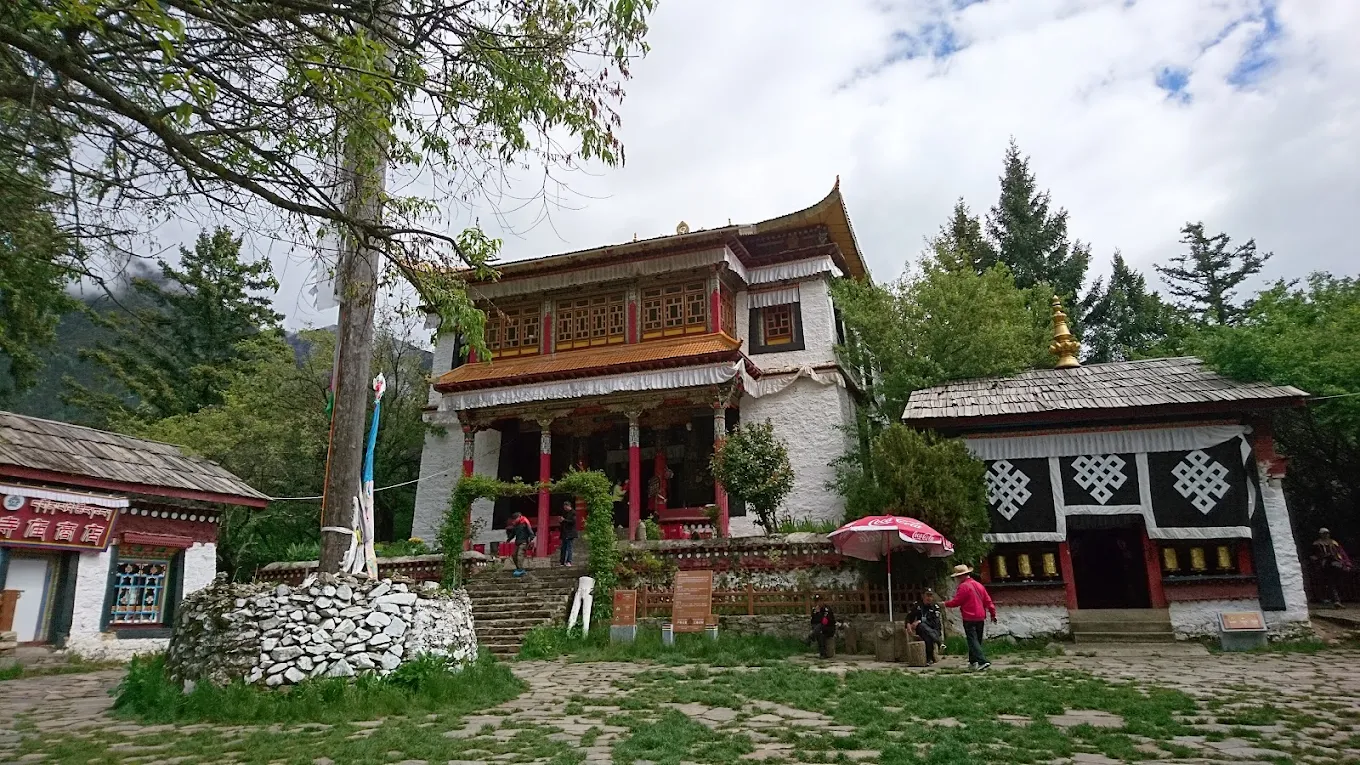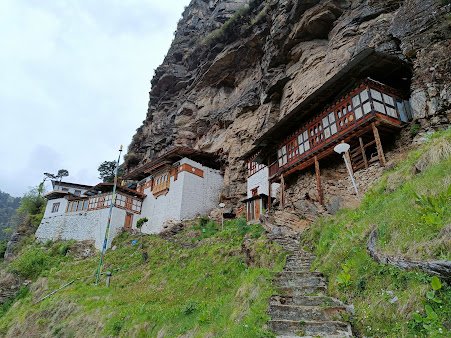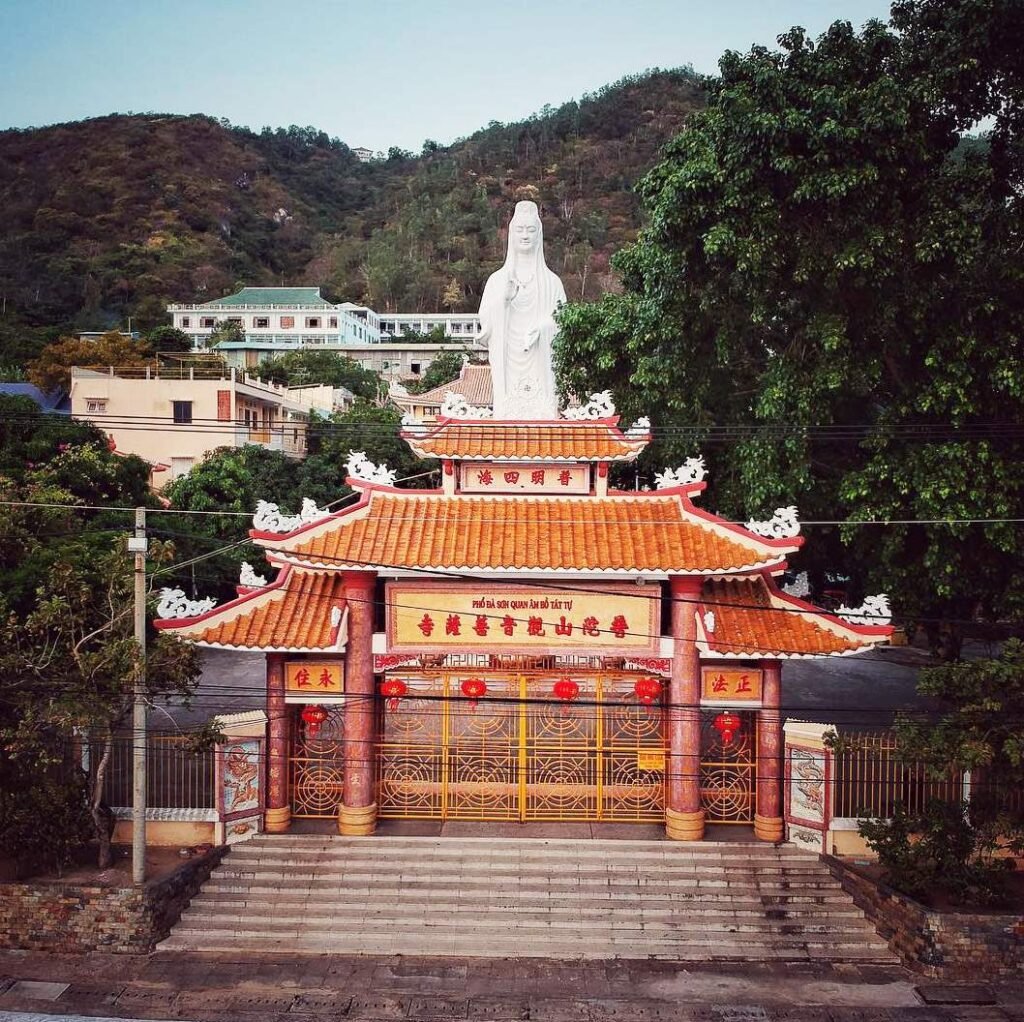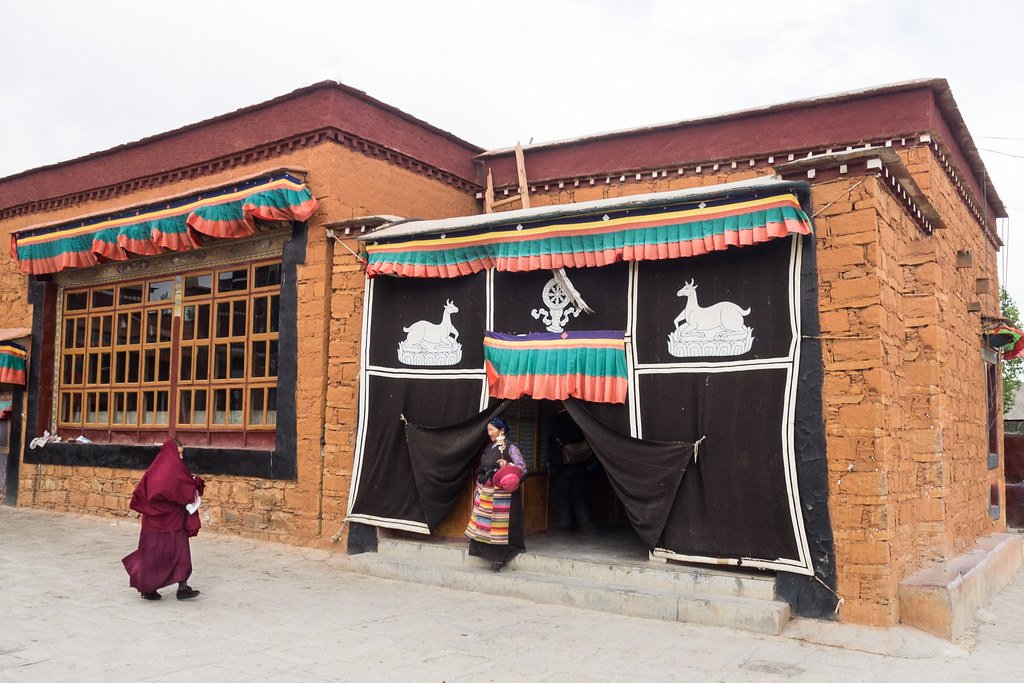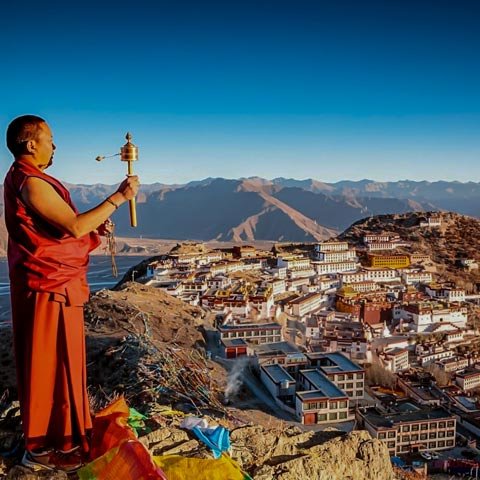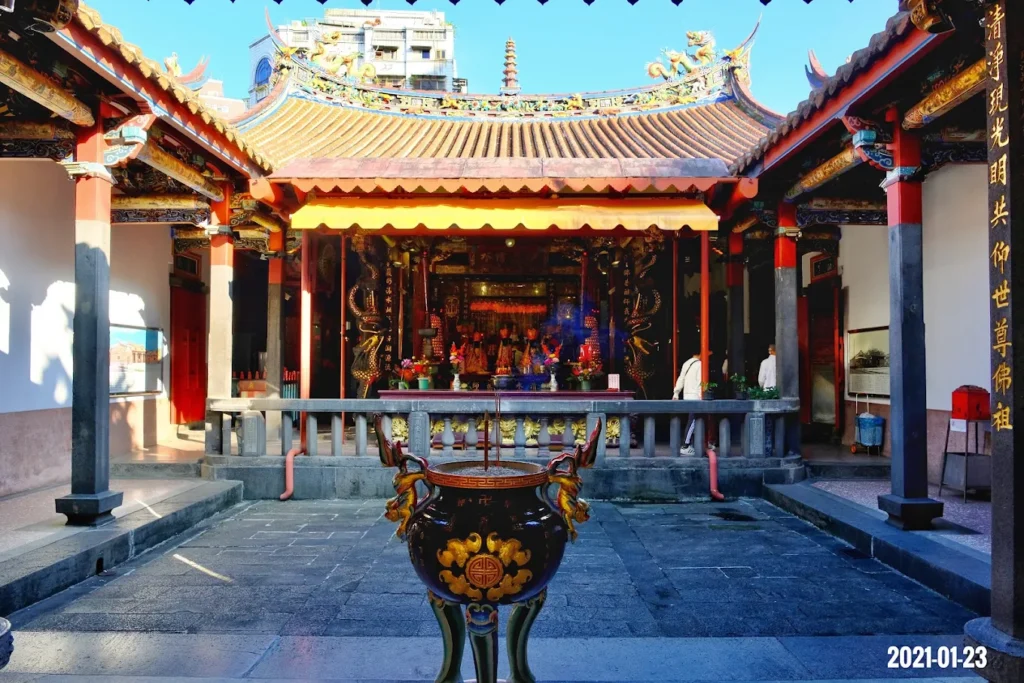Tsozong Gongba Monastery: The Island Sanctuary of Nyingma Serenity
Tsozong Gongba Monastery, nestled on Tashi Island in the tranquil waters of Pagsum Lake, within the Nyenchen Tanglha Mountains of Gongbo’gyamda County, Nyingchi Prefecture, Tibet, stands as a sacred haven of the Nyingma sect. Founded in 1400 by Sungye Lingpa, this serene gompa, meaning “castle in the lake,” radiates spiritual purity, its modest halls housing restored statues of Chenresig, Guru Rinpoche, and Sakya Thukpa. At 3,200 meters, its whitewashed walls and golden roofs gleam against the lake’s emerald embrace, captivating pilgrims and travelers with its ethereal allure. This immersive listing unveils Tsozong Gongba’s essence, guiding you through its storied past, architectural charm, sacred rituals, and practical visitor insights, offering a journey into a hidden gem of Tibetan Buddhism.
The Sacred Island of Tsozong Gongba
Essence of Tsozong Gongba Monastery
Tsozong Gongba Monastery glows with a quiet spiritual potency, embodying the Nyingma sect’s devotion to Guru Rinpoche and Dzogchen teachings. Established in 1400 by Sungye Lingpa, it serves as a spiritual retreat on Tashi Island, its lake setting symbolizing purity and isolation. Its defining feature—a restored Guru Rinpoche statue, blessed with sacred relics—anchors its identity as a meditative sanctuary. Encircled by Pagsum Lake’s serene waters, Tsozong Gongba’s tranquil seclusion invites profound contemplation of Tibet’s spiritual heritage.
- Spiritual Core: Nyingma sect retreat, Dzogchen focus.
- Iconic Feature: Restored Guru Rinpoche statue, sacred relic.
- Cultural Role: Preserver of Nyingma meditative traditions.
Historical Evolution
Tsozong Gongba’s story began in 1400 when Sungye Lingpa, a Nyingma master, founded the monastery on Tashi Island, a site blessed by Guru Rinpoche’s meditation, leaving spiritual imprints in its caves. The gompa thrived as a center for Nyingma practices until the Cultural Revolution (1966–1976), when its statues and texts were destroyed by the People’s Liberation Army. Restoration in the 1980s, led by lamas like Dudjom Rinpoche and his son Chuni Rinpoche, recast the statues of Chenresig, Guru Rinpoche, and Sakya Thukpa, reviving its spiritual life. Today, a small community of nuns maintains its sanctity, as noted in Wikipedia and Mysterious Tibet.
- Founding: Built in 1400 by Sungye Lingpa.
- Cultural Revolution: Statues, texts destroyed, 1966–1976.
- Restoration: Revived in 1980s by Dudjom Rinpoche.
Cultural Impact
Tsozong Gongba’s island setting and Nyingma rituals have preserved Tibet’s esoteric traditions, fostering Dzogchen meditation in a remote enclave. Its restoration efforts reflect the resilience of Nyingma practices, with its thangkas and statues studied via HimalayanArt.org. Annual festivals, like the Guru Rinpoche Tsechu, draw Gongbo’gyamda pilgrims, maintaining vibrant customs. Globally, the monastery’s niche allure attracts cultural enthusiasts through travel narratives on Trek Zone and Mandalas Life, resonating with those exploring Tibet’s spiritual depths.
- Nyingma Legacy: Preserves Dzogchen meditation practices.
- Festival Traditions: Guru Rinpoche Tsechu draws pilgrims.
- Global Appeal: Niche destination for cultural enthusiasts.
Signature Legacy
The restored Guru Rinpoche statue, recast in the 1980s, is Tsozong Gongba’s crowning jewel, its serene gaze and sacred relics radiating blessings, believed to embody Guru Rinpoche’s meditative presence. A small chorten in the courtyard, commemorating Sungye Lingpa’s founding, symbolizes the monastery’s spiritual continuity. A legend recounts how Guru Rinpoche left a spiritual imprint in a nearby cave, affirming Tsozong Gongba’s sanctity as a “castle in the lake.” These elements define its spiritual and historical allure.
- Guru Rinpoche Statue: 1980s recast, sacred relics.
- Sungye Lingpa Chorten: Commemorates 1400 founding.
- Cave Imprint Legend: Guru Rinpoche’s spiritual blessing.
Community and Global Reach
Gongbo’gyamda locals revere Tsozong Gongba, offering butter lamps during festivals and life events, viewing it as a protective sanctuary. Its small community of 5–10 nuns upholds rituals and guides visitors, fostering spiritual continuity despite its modest scale. The Tibetan diaspora connects through Nyingma networks, while international tourists, drawn by Tibet Travel and OpenTripMap, seek its serene authenticity. Social media posts on X highlight its island beauty, linking Tsozong Gongba to global Buddhist communities.
- Local Devotion: Butter lamp offerings by Gongbo’gyamda residents.
- Monastic Community: 5–10 nuns maintain rituals.
- Global Appeal: Attracts diaspora, niche tourists.
Architectural Charm of Tsozong Gongba
Distinctive Design
Tsozong Gongba’s architecture, spanning 1,000 square meters at 3,200 meters, blends 14th-century Nyingma simplicity with its unique island setting, its whitewashed walls and golden roofs harmonizing with Pagsum Lake’s emerald waters. The monastery comprises four buildings around a central courtyard, centered on the Tsuglhakhang (main hall), reflecting a mandala-like layout. The lake’s isolation enhances its spiritual ambiance, creating a serene aesthetic unique to Tsozong Gongba’s “castle in the lake” identity.
- Style: 14th-century Nyingma, island mandala layout.
- Layout: Tsuglhakhang, four courtyard buildings, chortens.
- Setting: White walls on Tashi Island, Pagsum Lake.
Signature Structures
The Tsuglhakhang, a single-story hall restored in the 1980s, enshrines the Guru Rinpoche statue alongside Chenresig and Sakya Thukpa, adorned with thangkas of Nyingma deities. Smaller chapels, dedicated to Tara and Vajrakilaya, glow with butter lamps and vibrant murals. The golden roofs, regilded post-restoration, reflect sunlight across the lake, while the kora path, encircling the island, features 108 prayer wheels and a chorten honoring Sungye Lingpa. These structures embody Tsozong Gongba’s spiritual serenity.
- Tsuglhakhang: Guru Rinpoche, Chenresig, Sakya Thukpa statues.
- Chapels: Tara, Vajrakilaya, vibrant murals.
- Golden Roofs: Regilded, lake-reflecting beacon.
Artisanal Mastery
Tsozong Gongba’s thangkas, crafted by local artisans, depict Nyingma deities with mineral pigments, their hues vibrant post-1980s restoration. The Guru Rinpoche statue, recast with sacred relics, showcases modern Tibetan sculptural finesse, echoing 14th-century artistry. Carved wooden beams, featuring lotus motifs, adorn the Tsuglhakhang, while silk thangkas of Sungye Lingpa hang in chapels. These works, preserved through restoration, highlight Tsozong Gongba’s artistic legacy.
- Thangkas: Nyingma deities, vibrant pigments.
- Guru Rinpoche Statue: 1980s recast, sacred relics.
- Wood Carvings: Lotus-motif beams, silk thangkas.
Hidden Architectural Gems
Tsozong Gongba conceals subtle treasures within its modest grounds. The kora path’s lakeside overlook offers breathtaking views of Pagsum Lake, framed by prayer flags. A faded mural in the Tsuglhakhang depicts Guru Rinpoche’s meditation, a historical snapshot. The courtyard’s mani stone pile, etched with Om Mani Padme Hum, invites quiet reflection, while a nearby cave shrine holds a stone with Guru Rinpoche’s spiritual imprint, believed to bless pilgrims.
- Kora Overlook: Pagsum Lake views.
- Meditation Mural: Guru Rinpoche artwork in Tsuglhakhang.
- Cave Imprint Shrine: Guru Rinpoche’s spiritual relic.
Preservation and Evolution
Preserving Tsozong Gongba’s structures is challenging in Nyingchi’s humid climate. Restoration since the 1980s, funded by local devotees and Nyingma patrons, used traditional pigments for thangkas and reinforced mud-brick walls. The golden roofs’ regilding post-restoration blended modern durability with 14th-century aesthetics. Ongoing efforts, supported by modest donations, aim to maintain the island’s fragile structures, ensuring Tsozong Gongba’s legacy endures despite environmental risks.
- Restoration: Pigments, wall reinforcements since 1980s.
- Golden Roofs: Regilded post-restoration.
- Funding: Local, Nyingma devotees.
Sacred Rites and Nyingma Devotion
Sacred Daily Rites
Each dawn, Tsozong Gongba awakens with soft chants, as nuns gather in the Tsuglhakhang, their voices harmonizing with butter lamp smoke. Pilgrims offer khatas (silk scarves) at the Guru Rinpoche statue, their prayers mingling with juniper incense. The hum of 108 prayer wheels along the kora path creates a meditative rhythm, enveloping visitors in Tsozong Gongba’s spiritual calm.
- Chanting: Morning sutras in Tsuglhakhang.
- Offerings: Khatas at Guru Rinpoche statue.
- Ambiance: Incense, prayer wheel hum.
Unique Spiritual Practices
Tsozong Gongba’s nuns perform Nyingma rituals, including Guru Rinpoche-focused recitations and Dzogchen meditations, reflecting the sect’s esoteric roots. Pilgrims walk the island kora, spinning prayer wheels to accrue merit, a practice enhanced by the lake’s purifying symbolism. The Chenresig chapel hosts compassion-focused blessings, unique to Tsozong Gongba’s terma tradition, believed to nurture spiritual awakening. These rituals, rooted in Sungye Lingpa’s legacy, deepen the monastery’s spiritual allure.
- Guru Rinpoche Rites: Nyingma recitations, meditations.
- Kora: Island prayer wheel circumambulation.
- Chenresig Blessings: Terma-inspired compassion rites.
Vibrant Festival Traditions
Tsozong Gongba’s festivals transform the island into a vibrant devotional hub. The Guru Rinpoche Tsechu, held in the tenth lunar month, features seven-day tantric rituals and Cham dances depicting Guru Rinpoche’s triumphs, drawing Gongbo’gyamda pilgrims by boat. Saka Dawa, marking Buddha’s enlightenment, includes kora walks, lamp offerings, and communal feasts of tsampa (roasted barley) and butter tea, uniting locals. These events reinforce Tsozong Gongba’s role as a cultural and spiritual anchor.
- Guru Rinpoche Tsechu: Seven-day tantric rites, Cham dances.
- Saka Dawa: Kora, lamp offerings, feasts.
- Community Role: Tsampa, tea shared.
Visitor Engagement
Visitors can offer khatas or light butter lamps at the Guru Rinpoche statue, guided by nuns, immersing in Tsozong Gongba’s spiritual life. Photography is permitted for a 10-yuan fee, capturing thangkas and lake views, but flash is prohibited, and close-up shots of the main statue are restricted. Joining the kora around the island lets travelers walk with pilgrims, feeling Tsozong Gongba’s sacred rhythm. Nuns may share tales of Guru Rinpoche’s cave imprint, enriching the visit with historical lore.
- Offerings: Khatas, lamps with nun guidance.
- Photography: 10-yuan fee, no flash, restricted statue shots.
- Kora Participation: Walk with pilgrims.
Monastic and Community Roles
Tsozong Gongba’s 5–10 nuns, primarily Nyingma, maintain daily rites, preserve terma texts, and guide visitors, upholding its esoteric legacy despite its small scale. They offer blessings for local harvests, weddings, and life events, strengthening Gongbo’gyamda ties. The monastery trains young nuns in thangka restoration, preserving Nyingma artistry. This bond ensures Tsozong Gongba remains a living spiritual center, fostering devotion in the lake’s embrace.
- Monastic Duties: Rites, text preservation, guidance.
- Community Ties: Blessings for local events.
- Art Preservation: Thangka restoration training.
Visiting Tsozong Gongba Monastery
Navigating to Tsozong Gongba Monastery
Tsozong Gongba lies on Tashi Island in Pagsum Lake, Gongbo’gyamda County, Nyingchi Prefecture, approximately 50 km west of Bayi Town and 450 km east of Lhasa. From Lhasa, a 450-km drive via the G318 highway takes 7–8 hours by private tour vehicle or bus, passing Bayi Town. From Bayi, a 1-hour drive west to Gongbo’gyamda County, followed by a 30-minute boat ride to Tashi Island, reaches the monastery, marked by its golden roofs. The nearby Basum Lake (50 km from Bayi) serves as a guiding landmark.
- From Lhasa: 7–8-hour drive, 450 km via Bayi.
- From Bayi Town: 1-hour drive to Gongbo’gyamda, 30-minute boat ride.
- Local Access: Boat from Gongbo’gyamda to Tashi Island.
Address of Tsozong Gongba Monastery
- Location: Tashi Island, Pagsum Lake, Gongbo’gyamda County, Nyingchi Prefecture, Tibet Autonomous Region, China.
- Coordinates: 29.6833° N, 93.9667° E (approximate).
- Context: Pagsum Lake, 50 km west of Bayi Town.
Visiting Hours and Etiquette
Tsozong Gongba is open daily from 9:00 AM to 5:00 PM, with early visits recommended for tranquility and to align with boat schedules. Dress modestly, covering shoulders and knees, and remove hats in the Tsuglhakhang to show respect. Photography is allowed for a 10-yuan fee; bring a flashlight for dim interiors, avoid flash, and note that close-up shots of the Guru Rinpoche statue are restricted. Respect pilgrims by maintaining silence, walking clockwise around sacred areas, and not touching relics or murals.
- Hours: 9:00 AM–5:00 PM, best in morning.
- Dress Code: Modest clothing, no hats in hall.
- Etiquette: 10-yuan photo fee, no flash, clockwise movement.
Accessibility and Safety
Tsozong Gongba’s island grounds are accessible via a short walk from the boat landing, but the Tsuglhakhang and chapels involve low doorways and steps, challenging for those with mobility issues. Wheelchair users require assistance due to the boat ride and uneven terrain; arrange with tour operators in Bayi. Nyingchi’s 3,200-meter altitude is lower than Lhasa, easing acclimatization, but hydrate and rest to avoid sickness. The lake setting is safe, but watch for boat overcrowding and carry cash for fees, as no facilities exist on the island.
- Accessibility: Short walk, low doorways, steps; boat ride required.
- Mobility Aids: Limited, arrange assistance.
- Safety: Acclimatize, watch for boat crowds, carry cash.
Amenities and Surroundings
Tsozong Gongba offers no restrooms, shops, or dining on Tashi Island; bring water, snacks, and essentials. Gongbo’gyamda’s markets, 20 km from the lake, serve momos (dumplings), butter tea, and yak-meat noodles, immersing visitors in local flavors. The island’s courtyard, with prayer flags and chortens, provides serene reflection spots. Pagsum Lake’s emerald waters, the Nyenchen Tanglha Mountains, and nearby Basum Lake (50 km east) offer scenic exploration, enriching the visit.
- Amenities: None on island, bring essentials.
- Food: Gongbo’gyamda markets with momos, tea.
- Surroundings: Courtyard, Pagsum Lake, Nyenchen Tanglha Mountains.
Immersive Visitor Tips
Arrive early to catch the morning boat, hearing nuns chant in the Tsuglhakhang, their voices resonating with butter lamp glow, setting a meditative tone. Photograph the golden roofs from the boat landing at midday, capturing their reflection in Pagsum Lake, paying the 10-yuan fee and avoiding flash. Walk the kora around the island at dusk, when the lake glows golden, enhancing Tsozong Gongba’s ethereal ambiance. Savor butter tea in Gongbo’gyamda’s markets, chatting with locals about Guru Rinpoche’s cave imprint for cultural insights.
- Dawn Visits: Hear chants in Tsuglhakhang, early boat.
- Photography: Golden roof lake shots, 10-yuan fee, no flash.
- Evening Kora: Lake views at dusk.
